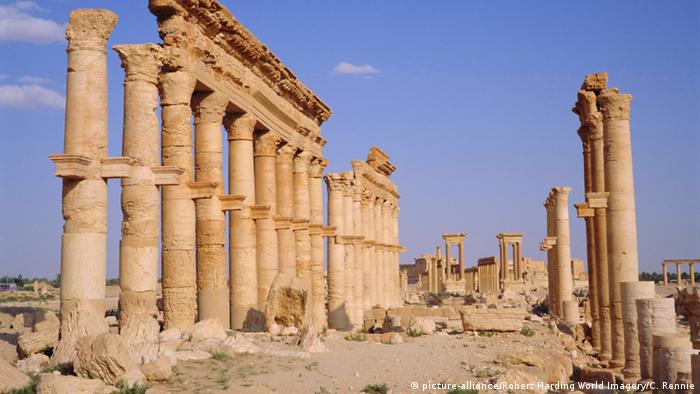A sign hanging from Mr. Asaad’s body said he had been killed because he had overseen Palmyra’s “idols” and attended “apostate” academic conferences abroad.
Islamic State militants have beheaded one of the Syria’s most prominent...
WSJ.COM|由 DANA BALLOUT 上傳
自5月份以來,“伊斯蘭國”控制了敘利亞東部沙漠綠洲古城帕爾米拉。現在據報導該市著名考古學者慘遭IS斬首。
(德國之聲中文網)"伊斯蘭國"民兵的行為再次顯示了他們的野蠻兇殘:現年82歲的敘利亞考古學者哈利德·阿薩德(Chaled al-Assad )被斬首,之後其屍首被懸掛在綠洲古城帕爾米拉的一個古羅馬廊柱上。敘利亞國家媒體和活動家團體證實了這一消息。"伊斯蘭國"在互聯網上公佈了屍首被捆綁在一個 古羅馬廊柱上的相關照片。
據敘利亞人權觀察站公佈的消息,阿薩德在帕爾米拉市博物館前的一個廣場上被當眾殺害,並稱這位曾經的帕爾米拉考古主管一個月前便被在帕爾米拉尋找黃金的IS成員逮捕。
最重要的考古專家之一
敘利亞文物部門負責人阿卜杜勒卡里姆(Maamun Abdelkarim)說,聖戰分子殺害的是敘利亞最重要的考古專家之一。
阿薩德曾任帕爾米拉市考古主管數十年。自2003年退休以來,一直繼續擔任政府機構的考古顧問。
"伊斯蘭國"因此將這位考古學家視為政府的追隨者,指責他代表敘利亞當權者巴沙爾·阿薩德領導的政府在國外與"無信仰者"一起出席會議。哈利德·阿薩德也曾參加有美、法、德和瑞士人參加的考古工作。
對歷史古蹟的擔憂
5月份 "伊斯蘭國"佔領了帕爾米拉。這個位於敘利亞中部的綠洲城市已被列入聯合國教科文組織的世界文化遺產名單。該城有大量保存完好的公元初的古蹟廢墟。7月份,IS民兵摧毀了帕爾米拉一個公元二世紀的著名獅子雕塑。據稱早在6月份,IS民兵就在城市埋設了地雷,因此人們一直擔心 極端分子有可能炸毀古遺跡。今年年初,伊拉克的IS武裝分子就摧毀了該國的許多古遺址。
They tortured him for a month to get information about the city and its treasures.
He refused to tell them anything.
Khaled Asaad, 82, is beheaded by militants outside the museum where he worked for more than 50 years looking after the city's ancient artefacts
Isis beheads Palmyra antiquities chief and hangs him from ruins he spent his life restoring
Isis beheads Palmyra antiquities chief and hangs him from ruins he spent his life restoring
INDEPENDENT.CO.UK
 File photo released on Sunday, 17 May shows general view of the ancient Roman city of Palmyra, northeast of Damascus, Syria (AP)According to the London-based Syrian Observatory for Human Rights, Mr Asaad was beheaded in the square outside the museum in Palmyra where he had been in charge since the 1960s.
File photo released on Sunday, 17 May shows general view of the ancient Roman city of Palmyra, northeast of Damascus, Syria (AP)According to the London-based Syrian Observatory for Human Rights, Mr Asaad was beheaded in the square outside the museum in Palmyra where he had been in charge since the 1960s.
READ MORE: UN: ASSAD STOPPED SYRIANS FLEEING FROM PALMYRA
Isis militants have tortured and executed the antiquities chief of the ancient city of Palmyra, according to Syrian officials and activists.
A graphic image posted online by Isis-affiliated social media accounts purported to show the decapitated body of 82-year-old Khaled Asaad, his distinctive glasses still placed on his head on the ground.
The head of Syria's department of antiquities said that militants later took Mr Asaad's body from the square where he was executed and hung it from a Roman column in one of the ruins he had dedicated more than 50 years of his life to restoring.
A placard attached to the remains pictured online reportedly claimed Mr Asaad had been killed for overseeing "idols" in the ancient city, attending "infidel" conferences as Syrian representative, and for staying in touch with his brother and with palace officials in the wake of Isis's takeover.
Maamoun Abdulkarim, based in Damascus, said Mr Asaad's family told him the scholar had been held and interrogated by Isis for at least the past month. He said Isis had tried to get information about the city's "treasures" from the expert, without success.
"Just imagine that such a scholar who gave such memorable services to the place and to history would be beheaded," he said. "His corpse [is] still hanging from one of the ancient columns in the centre of a square in Palmyra.
"The continued presence of these criminals in this city is a curse and bad omen on (Palmyra) and every column and every archaeological piece in it."
 File photo released on Sunday, 17 May shows general view of the ancient Roman city of Palmyra, northeast of Damascus, Syria (AP)According to the London-based Syrian Observatory for Human Rights, Mr Asaad was beheaded in the square outside the museum in Palmyra where he had been in charge since the 1960s.
File photo released on Sunday, 17 May shows general view of the ancient Roman city of Palmyra, northeast of Damascus, Syria (AP)According to the London-based Syrian Observatory for Human Rights, Mr Asaad was beheaded in the square outside the museum in Palmyra where he had been in charge since the 1960s.
One of the foremost experts on Palmyra, he published several works in international journals about the city, which was an important trading hub along the Silk Road and still ranks among the finest ancient ruins in the Middle East.
READ MORE: UN: ASSAD STOPPED SYRIANS FLEEING FROM PALMYRA
IRAQ RUSHES TO DIGITISE ARCHIVES UNDER THREAT OF ISIS ADVANCE
ISIS PICTURED IN NEW ASSAULT ON PALMYRA'S ANCIENT RUINS
Mr Asaad worked with archaeological missions from the US, France, Germany and Switzerland on excavations at the 2,000-year-old UNESCO World Heritage Site.
Isis overran Palmyra and the neighbouring modern city of Tadmur in May this year.
The militant group was known to have destroyed relics it regarded as "idolatrous" in the past, and some of the city's smaller artefacts were moved to safety as government forces retreated.
It remains unclear how much damage has been done to the ruins since. Isis has previously said it will not destroy the overarching Roman structures - but in June it did blow up two ancient shrines in the city, not part of the Roman-era complex, which militants said were sacrilegious.












沒有留言:
張貼留言